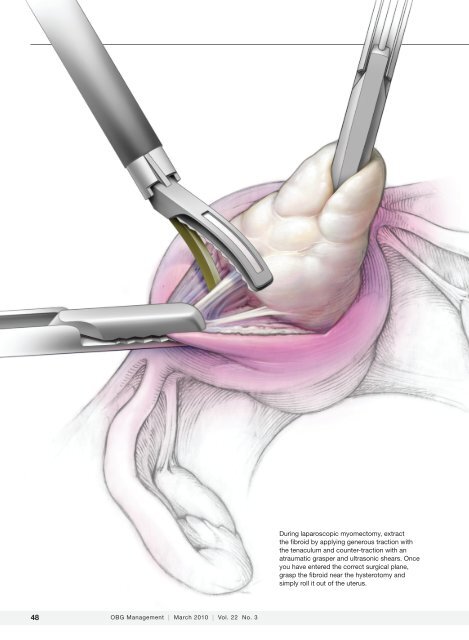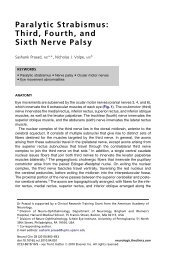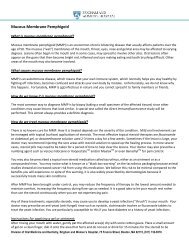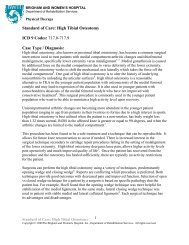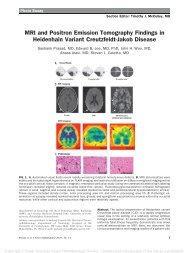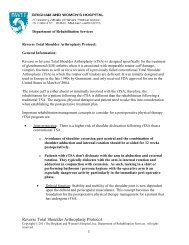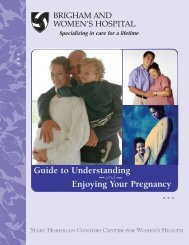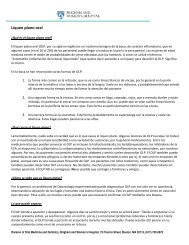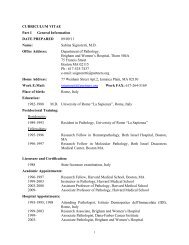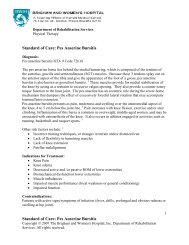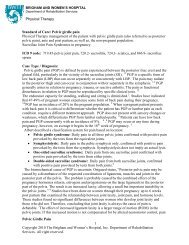Laparoscopic Myomectomy - Brigham and Women's Hospital
Laparoscopic Myomectomy - Brigham and Women's Hospital
Laparoscopic Myomectomy - Brigham and Women's Hospital
Create successful ePaper yourself
Turn your PDF publications into a flip-book with our unique Google optimized e-Paper software.
48 OBG Management | March 2010 | Vol. 22 No. 3<br />
During laparoscopic myomectomy, extract<br />
the fibroid by applying generous traction with<br />
the tenaculum <strong>and</strong> counter-traction with an<br />
atraumatic grasper <strong>and</strong> ultrasonic shears. Once<br />
you have entered the correct surgical plane,<br />
grasp the fibroid near the hysterotomy <strong>and</strong><br />
simply roll it out of the uterus.
SCOTT BODELL FOR OBG MANAGEMENT<br />
<strong>Laparoscopic</strong> myomectomy:<br />
8 Pearls<br />
Jon I. Einarsson,<br />
MD, MPH<br />
Dr. Einarsson is Assistant Professor<br />
of Obstetrics, Gynecology, <strong>and</strong><br />
Reproductive Biology at Harvard<br />
Medical School <strong>and</strong> Chief of the<br />
Division of Minimally Invasive<br />
Gynecology at <strong>Brigham</strong> <strong>and</strong><br />
Women’s <strong>Hospital</strong> in Boston.<br />
The author reports no financial<br />
relationships relevant to this article.<br />
›› SHARE YOUR EXPERIENCE!<br />
How do you select patients for<br />
laparoscopic myomectomy?<br />
E-MAIL obg@qhc.com<br />
FAX 973-206-9251<br />
SURGICAL TECHNIQUES<br />
From preoperative imaging to postoperative analgesia,<br />
the choices you make determine the ease of the<br />
procedure <strong>and</strong> the quality of the outcome<br />
<strong>Myomectomy</strong> is the surgery of choice for women<br />
who have symptomatic fibroids <strong>and</strong> who wish to<br />
retain their uterus. And laparoscopic myomectomy<br />
is preferable to the abdominal approach in many ways,<br />
offering: 1-4<br />
• faster recovery<br />
• a shorter hospital stay<br />
• diminished blood loss<br />
• decreased adhesion formation<br />
• a comparable or higher rate of pregnancy.<br />
Nevertheless, laparoscopic myomectomy is a technically<br />
challenging procedure with surgeon-specific limitations.<br />
The biggest challenge: appropriately suturing the<br />
hysterotomy site.<br />
In this article, I share my experience with laparoscopic<br />
myomectomy <strong>and</strong> offer 8 pearls that may contribute to a<br />
successful outcome.<br />
Don’t settle on<br />
1. laparoscopy prematurely<br />
Given its advantages over the abdominal route, laparoscopic<br />
myomectomy should be the preferred approach in the<br />
treatment of symptomatic uterine fibroids (FIGURE 1, page<br />
50). However, not all patients are appropriate c<strong>and</strong>idates for<br />
laparoscopy. Several guidelines have recommended a maximum<br />
number <strong>and</strong> size of fibroids for laparoscopic removal,<br />
but practice varies widely, <strong>and</strong> experienced surgeons successfully<br />
take on cases that are well beyond the limits set by<br />
most published guidelines. 5-7<br />
IN THIS<br />
ARTICLE<br />
When <strong>and</strong> how to<br />
treat uterine fibroids<br />
page 50<br />
How MRI can guide<br />
treatment: 3 cases<br />
page 53<br />
Should you worry<br />
about uterine rupture<br />
in postmyomectomy<br />
pregnancy?<br />
page 58<br />
Watch the author<br />
remove a fibroid at<br />
obgmanagement.com<br />
CONTINUED ON PAGE 50<br />
obgmanagement.com Vol. 22 No. 3 | March 2010 | OBG Management 49
SURGICAL TECHNIQUES / LAPAROSCOPIC MYOMECTOMY<br />
FIGURE 1 When <strong>and</strong> how to treat uterine fibroids<br />
50<br />
YES<br />
Hysteroscopic or<br />
laparoscopic fibroid<br />
resection<br />
Hysterectomy<br />
Medications<br />
Pro<br />
No surgery<br />
Infertility with<br />
submuscosal fibroid?<br />
Submucosal<br />
Hysteroscopic<br />
fibroid resection<br />
Cons<br />
Limited data <strong>and</strong><br />
experience<br />
Potential side effects<br />
with long-term therapy<br />
NO<br />
No treatment needed<br />
Cons<br />
Not suitable for<br />
all fibroids<br />
High recurrence rate on<br />
short-term follow-up<br />
NO<br />
Cons<br />
Surgery<br />
Unknown long-term<br />
reoperation rate<br />
OBG Management | March 2010 | Vol. 22 No. 3<br />
Uterine fibroids<br />
Symptoms?<br />
YES<br />
Future pregnancy<br />
possible or desired?<br />
NO YES<br />
Location of fibroids?<br />
NO<br />
MRI-guided<br />
focused ultrasound<br />
Pro<br />
No surgery<br />
Intramural or<br />
subserosal<br />
Desires uterine<br />
preservation?<br />
YES<br />
<strong>Laparoscopic</strong> uterine<br />
artery occlusion<br />
Pro<br />
Allows for concomitant<br />
removal of uterine<br />
fibroids <strong>and</strong><br />
other pathology<br />
Submucosal<br />
Hysteroscopic<br />
fibroid resection<br />
Uterine fibroid<br />
embolization<br />
Pro<br />
No surgery<br />
Location of fibroids?<br />
Cons<br />
20%-25%<br />
reoperation rate<br />
Small risk of premature<br />
ovarian failure<br />
Intramural or<br />
subserosal<br />
<strong>Myomectomy</strong><br />
<strong>Myomectomy</strong><br />
Pros<br />
Allows for future fertility<br />
Excellent for<br />
bulk symptoms<br />
Cons<br />
15%-20%<br />
reoperation rate<br />
General anesthesia<br />
CONTINUED ON PAGE 52
Submucosal <strong>and</strong><br />
intracavitary fibroids<br />
smaller than 4 cm<br />
<strong>and</strong> more than 5 mm<br />
away from the<br />
uterine serosa are<br />
generally removed<br />
hysteroscopically<br />
52<br />
SURGICAL TECHNIQUES / LAPAROSCOPIC MYOMECTOMY<br />
At our institution, we do not have firm<br />
guidelines in place for the number <strong>and</strong> size of<br />
fibroids that can be removed laparoscopically.<br />
Other variables enter into decision-making<br />
<strong>and</strong> counseling, among them any medical comorbidity<br />
or history of uterine surgery the patient<br />
may have, as well as her desires in regard<br />
to childbearing <strong>and</strong> uterine retention.<br />
Hysterectomy may be the most straightforward<br />
option for women who have symptomatic<br />
fibroids <strong>and</strong> who have completed<br />
childbearing. However, myomectomy is also<br />
appropriate as long as the patient is aware of<br />
the risk that fibroids may recur <strong>and</strong> the potential<br />
for further surgery. When the patient is in<br />
her late 40s or early 50s, the likelihood of fibroid<br />
recurrence may be lower than it is in the<br />
general population.<br />
In my practice, submucosal <strong>and</strong> intracavitary<br />
fibroids smaller than 4 cm <strong>and</strong> more than<br />
5 mm away from the uterine serosa are generally<br />
removed hysteroscopically, an approach<br />
beyond the scope of this article. In women<br />
who have completed childbearing but who<br />
wish to conserve the uterus, we deliberately<br />
enter the uterine cavity laparoscopically because<br />
this strategy allows for efficient removal<br />
of submucosal <strong>and</strong> intracavitary fibroids.<br />
Estimate the<br />
2. duration of surgery<br />
When the patient has fibroids that are intramural<br />
or subserosal, our general rule of thumb<br />
is to determine her suitability for laparoscopic<br />
myomectomy, based on the estimated duration<br />
of the operation. A surgeon’s ability to<br />
calculate the length of the operation for a particular<br />
patient increases with experience.<br />
We tend to recommend the laparoscopic<br />
approach when the procedure is expected to<br />
take less than 3 hours to complete. More than<br />
95% of our patients fall into this category.<br />
When we anticipate a prolonged operating<br />
time, we discuss the option of h<strong>and</strong>-assisted<br />
laparoscopic myomectomy. This approach<br />
involves two or three 5-mm trocar punctures<br />
high on the abdomen in conjunction with a<br />
suprapubic incision, 6 to 7 cm in length with<br />
a h<strong>and</strong> port in place. Prospective studies have<br />
OBG Management | March 2010 | Vol. 22 No. 3<br />
demonstrated a significantly longer recovery<br />
with minilaparotomy than with laparoscopy,<br />
but these trials compared uteri of similar<br />
size. 4,8 We expect the laparoscopic approach to<br />
confer fewer advantages when operative time<br />
is prolonged significantly.<br />
In our practice, we consider one or more<br />
of the following conditions appropriate for<br />
h<strong>and</strong>-assisted laparoscopic myomectomy:<br />
• a very large uterus (i.e., heavier than<br />
1,500 to 2,000 g). In these cases, operating<br />
times can be excessive because of the<br />
need for extensive suturing <strong>and</strong> morcellation,<br />
<strong>and</strong> bleeding may increase as a result<br />
• more than 20 fibroids on magnetic resonance<br />
imaging (MRI). It can be a challenge<br />
to locate all of the fibroids; multiple<br />
uterine incisions may be necessary<br />
• a medical comorbidity that renders the<br />
patient unable to tolerate prolonged anesthesia.<br />
For example, we operated on a patient<br />
who had Ehlers-Danlos syndrome <strong>and</strong><br />
who needed to avoid a prolonged operation<br />
due to fragile bones <strong>and</strong> joint laxity.<br />
Of necessity, these guidelines will vary<br />
from practice to practice, <strong>and</strong> gynecologic<br />
surgeons who are just beginning to perform<br />
laparoscopic myomectomy should not include<br />
multiple fibroids or a large uterus among their<br />
initial cases. Instead, perform the first few cases<br />
in patients who have not had abdominal surgery<br />
<strong>and</strong> who have a symptomatic intramural<br />
or subserosal fibroid that is close to the uterine<br />
fundus <strong>and</strong> no larger than 6 cm in diameter.<br />
3. Consider<br />
preoperative MRI<br />
Preoperative imaging greatly supplements<br />
the clinical examination <strong>and</strong> facilitates<br />
identification of the number, location, <strong>and</strong><br />
characteristics of the fibroids. Pelvic ultrasonography<br />
(US) is appropriate for most patients.<br />
We prefer preoperative MRI of the<br />
pelvis in the following scenarios:<br />
• uterus larger than 12 weeks (280 g) on<br />
clinical examination<br />
• identification of multiple fibroids via US<br />
• history suggestive of adenomyosis.<br />
MRI facilitates preoperative planning by<br />
CONTINUED ON PAGE 53
accurately delineating the size <strong>and</strong> location of<br />
the fibroids, <strong>and</strong> by distinguishing between<br />
an adenomyoma <strong>and</strong> fibroid in most cases. 9<br />
For an example of its utility, see “How MRI can<br />
guide treatment: 3 cases.”<br />
Preoperative medical<br />
4. therapy may be indicated<br />
When given preoperatively, gonadotropinreleasing<br />
hormone (GnRH) agonists have<br />
been shown to reduce blood loss <strong>and</strong> shorten<br />
operative time. The exception: cases involving<br />
hypoechoic fibroids, because the cleavage<br />
plane may be more difficult to identify, prolonging<br />
operative time. 10<br />
We generally prefer to use a GnRH agonist<br />
in two clinical scenarios: 1) anemia <strong>and</strong> 2) a<br />
uterus that extends above the umbilicus. In<br />
the second scenario, the GnRH agonist helps<br />
reduce the uterus to a more manageable size.<br />
Aromatase inhibitors show great promise<br />
as preoperative agents because there is<br />
no initial flare. In addition, because fibroids<br />
have a higher concentration of aromatase<br />
activity than the surrounding myometrium,<br />
a low dosage of an aromatase inhibitor is effective<br />
<strong>and</strong> does not cause significant menopausal<br />
symptoms.<br />
A recent comparative study found that fibroid<br />
shrinkage was greater after 3 months of<br />
letrozole (2.5 mg/day) than after use of a GnRH<br />
agonist. 11 Total myoma volume decreased by<br />
45.6% in the letrozole group, compared with<br />
33.2% in the group that received a GnRH agonist<br />
(P = .02). 11<br />
Aromatase inhibitors have also been<br />
successfully used during the initial period of<br />
GnRH agonist therapy to prevent the symptoms<br />
of flare. 12 However, because clinical experience<br />
is limited, the long-term efficacy <strong>and</strong><br />
safety of aromatase inhibitors in premenopausal<br />
women is unknown.<br />
Use careful surgical<br />
5. technique<br />
Pay attention to set-up, initial entry<br />
Although we lack definitive data on the<br />
practical utility of preoperative, intravenous<br />
SURGICAL TECHNIQUES / LAPAROSCOPIC MYOMECTOMY<br />
How MRI can guide treatment: 3 cases<br />
CASE 1<br />
Findings A 40-year-old nulliparous<br />
woman seeks treatment for menometrorrhagia<br />
<strong>and</strong> dysmenorrhea but<br />
wants to conserve her uterus. MRI<br />
reveals a 4.5-cm submucosal fibroid<br />
(arrow) that extends all the way to<br />
the uterine serosa, with no evidence<br />
of adenomyosis. Her thyroid-stimulating<br />
hormone (TSH) level is normal,<br />
as is an endometrial biopsy.<br />
Outcome We decide to proceed<br />
with laparoscopic myomectomy because<br />
a hysteroscopic approach would carry a risk of uterine rupture.<br />
CASE 2<br />
Findings A 36-year-old nulliparous<br />
woman complains of significant<br />
“bulk” symptoms (heaviness, urinary<br />
frequency, <strong>and</strong> abdominal bloating).<br />
She has a visible mass that extends<br />
four finger-breadths above the<br />
umbilicus. Pelvic MRI reveals multiple<br />
intramural fibroids in a uterus<br />
estimated to weigh roughly 2,850 g.<br />
The patient is given a 3-month<br />
course of a GnRH agonist.<br />
Outcome After treatment with the<br />
GnRH agonist, the patient undergoes h<strong>and</strong>-assisted, laparoscopic,<br />
multiple myomectomy. She is discharged home the following day <strong>and</strong><br />
resumes normal activities within two weeks.<br />
CASE 3<br />
Findings A 32-year-old nulliparous<br />
patient seeks treatment for<br />
menomenorrhagia <strong>and</strong> symptoms<br />
of bulk <strong>and</strong> expresses a desire for<br />
uterine conservation. Pelvic MRI<br />
reveals two distinct intramural<br />
fibroids, 6 cm <strong>and</strong> 9 cm in size.<br />
Outcome The patient undergoes<br />
laparoscopic myomectomy without<br />
preoperative treatment with a<br />
GnRH agonist <strong>and</strong> is discharged<br />
home the same day without postoperative<br />
complication. (Although the uterus had two large fibroids,<br />
we did not use a GnRH agonist because the uterus was well below<br />
the belly button.)<br />
obgmanagement.com Vol. 22 No. 3 | March 2010 | OBG Management 53
SURGICAL TECHNIQUES / LAPAROSCOPIC MYOMECTOMY<br />
FIGURE 2 <strong>Laparoscopic</strong> port placement<br />
Place the camera through the umbilical port (A) <strong>and</strong> operate through two<br />
additional ports on the left-h<strong>and</strong> side of the patient, where the primary surgeon<br />
st<strong>and</strong>s. Place the first operative port two finger-breadths medial <strong>and</strong> superior to<br />
the iliac spine (B) <strong>and</strong> the second port 8 cm cephalad to the first (C).<br />
The pattern<br />
of blood vessels<br />
along the uterus is<br />
heterogeneous <strong>and</strong><br />
variable, <strong>and</strong> there<br />
is no evidence<br />
that blood loss or<br />
other outcomes<br />
are affected by the<br />
direction of the<br />
uterine incision<br />
54<br />
X A<br />
X<br />
X B<br />
(IV) antibiotics, we administer cefazolin prophylactically,<br />
switching to IV clindamycin if<br />
there is a documented allergy to penicillin.<br />
In addition, a uterine manipulator is<br />
helpful when the patient has a small or medium-sized<br />
uterus. A variety of manipulators are<br />
available, but we generally use the VCare manipulator<br />
(ConMed Corp) because it is easy to<br />
insert <strong>and</strong> provides excellent uterine mobility.<br />
Initial entry is at the umbilicus, unless the<br />
uterus extends above the umbilicus, in which<br />
case we enter in the left upper quadrant. We<br />
generally place the camera through the umbilical<br />
port <strong>and</strong> use two parallel operative<br />
ports on the left side of the patient, where the<br />
primary surgeon st<strong>and</strong>s. A detailed description<br />
of our laparoscopic entry technique was<br />
published recently. 13<br />
Place the first trocar two finger-breadths<br />
medial <strong>and</strong> superior to the iliac spine <strong>and</strong> the<br />
second trocar 8 cm cephalad to the first port<br />
(FIGURE 2). In a large uterus, trocars may have<br />
to be placed higher on the abdomen. A third<br />
operative port may be added on the right side,<br />
if it is needed.<br />
Incise the uterus<br />
Infiltrate the uterus with dilute vasopressin<br />
(20 U in 60 mL of saline), taking care to<br />
OBG Management | March 2010 | Vol. 22 No. 3<br />
C<br />
administer no more than 10 U at a time to<br />
minimize the potential for cardiovascular<br />
side effects such as bradycardia <strong>and</strong> hypertension.<br />
14 In the past, we periodically encountered<br />
episodes of bradycardia when we used<br />
20 U in 40 mL of saline, but we have not had<br />
that problem since we changed to a more dilute<br />
vasopressin <strong>and</strong> used no more than 10<br />
U at a time. It may be that an even smaller<br />
amount of vasopressin is just as effective, but<br />
we do not yet have sufficient data on myomectomy<br />
to determine whether that is the case.<br />
Inject the vasopressin subserosally <strong>and</strong><br />
along the planned hysterotomy. The fibroid<br />
itself contains no blood vessels, but the blood<br />
supply to the fibroid generally assumes a coronal<br />
pattern around it. 15 Therefore, it is important<br />
to inject the vasopressin into the correct<br />
subserosal plane.<br />
We prefer to make a horizontal hysterotomy<br />
using the Harmonic Scalpel (Ethicon<br />
Endo-Surgery), but other energy sources, such<br />
as a monopolar hook or bipolar spatula, are<br />
also appropriate.<br />
We choose a horizontal incision because<br />
of the ipsilateral port placement we use for<br />
suturing. Surgeons who use a midline or contralateral<br />
port for suturing may find it easier<br />
to repair a vertical hysterotomy. The pattern<br />
of blood vessels along the uterus is heterogeneous<br />
<strong>and</strong> variable, <strong>and</strong> there is no evidence<br />
that blood loss or other outcomes are affected<br />
by the direction of the uterine incision. 15<br />
Once the uterus has been incised, it is important<br />
to work efficiently because bleeding<br />
will probably continue until the hysterotomy<br />
site is completely closed.<br />
Extract the fibroid (“rock <strong>and</strong> roll”)<br />
Extract the fibroid from the uterus by applying<br />
generous traction using a tenaculum, <strong>and</strong><br />
by applying counter-traction using an atraumatic<br />
grasper <strong>and</strong> the Harmonic Scalpel, as<br />
needed. We try to limit the use of thermal energy<br />
during this step.<br />
The most important aspect of fibroid<br />
extraction is ensuring entry into the correct<br />
plane. Appropriate entry makes it possible<br />
to remove most fibroids without the need for<br />
sharp or thermal dissection.<br />
CONTINUED ON PAGE 58
SURGICAL TECHNIQUES / LAPAROSCOPIC MYOMECTOMY<br />
Should you worry about uterine rupture<br />
in postmyomectomy pregnancy?<br />
Pregnancy outcomes after laparoscopic myomectomy are generally<br />
favorable, with a pregnancy rate that is comparable to or even higher<br />
than the rate associated with abdominal myomectomy. 1-4<br />
Uneventful vaginal deliveries following laparoscopic myomectomy<br />
have been reported in several case series, but so have a number<br />
of cases of gravid uterine rupture. 5 In a recent study involving 2,050<br />
laparoscopic myomectomies, investigators tracked 386 post-myomectomy<br />
pregnancies, 309 deliveries in all, of which 68 were vaginal<br />
deliveries. 25 It found one case of uterine rupture documented at 33<br />
weeks in a woman who had undergone adenomyomectomy. 25<br />
Overall, the literature suggests that uterine rupture after laparoscopic<br />
myomectomy is a rare event, occurring in fewer than 1% of<br />
pregnancies. Some surgeons use a somewhat arbitrary rule of thumb<br />
requiring cesarean delivery if the uterine cavity is entered at myomectomy.<br />
This practice is not based on hard evidence, but it does make<br />
intuitive sense. If the uterine cavity is entered during myomectomy, it<br />
creates a transmural defect that may be more difficult to repair <strong>and</strong><br />
could carry a higher risk of rupture.<br />
Uterine rupture has also occurred several years after removal of<br />
a pedunculated fibroid, suggesting that the use of electrosurgery may<br />
weaken the uterine muscle <strong>and</strong> increase the risk of rupture.<br />
In general—<strong>and</strong> regardless of the depth of the hysterotomy—it is<br />
advisable to counsel patients who have undergone laparoscopic myomectomy<br />
that the uterus heals with a scar that may be slightly weaker<br />
than the normal myometrium <strong>and</strong> that elective cesarean delivery may be<br />
the optimal strategy. However, a trial of labor is a reasonable alternative,<br />
provided the patient receives careful surveillance in a hospital setting.<br />
58<br />
If you are not sure whether you have entered<br />
the correct plane, it is better to cut into<br />
the fibroid rather than remain too shallow. If<br />
you do not enter all the way into the correct<br />
plane, you run the risk of pulling <strong>and</strong> tearing<br />
uterine muscle fibers <strong>and</strong> causing bleeding.<br />
We describe the technique of fibroid<br />
extraction as “rock <strong>and</strong> roll” because it is<br />
generally easier to grab the fibroid near the<br />
hysterotomy <strong>and</strong> roll it out rather than pull<br />
on the portion of the fibroid that protrudes<br />
from the uterus (see the image on page 48,<br />
for example).<br />
Close the myometrium<br />
In the event of inadvertent entry into the uterine<br />
cavity, close the endometrial defect using<br />
running 2-0 polyglactin 910 suture, taking care<br />
58 OBG Management | March 2010 | Vol. 22 No. 3<br />
to avoid suture entry into the uterine cavity. Tie<br />
this suture using intracorporeal knot-tying.<br />
Close the hysterotomy in layers using 14 x<br />
14 cm bidirectional barbed 0 PDO suture on a<br />
36-mm, half-circle, taper-point needle. If the<br />
hysterotomy is longer than 8 cm, we prefer to<br />
use 24 x 24 cm suture.<br />
Tack the first needle into the opposite anterior<br />
abdominal wall to help prevent tangling<br />
of the suture. Close the deepest layer using the<br />
first needle <strong>and</strong> the more superficial layer <strong>and</strong><br />
serosa using the second needle. Then cut the<br />
needles. Because of the uniform tension <strong>and</strong><br />
bidirectional nature of the barbed suture, no<br />
knots are required.<br />
We began using Quill bidirectional<br />
barbed suture (Angiotech) in March 2008. 16<br />
Since then, we have completed almost 300<br />
laparoscopic cases using this material, including<br />
approximately 100 laparoscopic myomectomies.<br />
We compiled data on our first year of<br />
experience with this material (TABLE, page 60),<br />
during which we had no major complications<br />
related to use of the suture, no conversions to<br />
laparotomy, <strong>and</strong> no returns to the OR to address<br />
bleeding or complications arising from<br />
the use of bidirectional barbed suture.<br />
The original version of barbed suture included<br />
a 6-cm segment of regular, smooth suture.<br />
If suturing extends to include this segment,<br />
apply a LapraTy clip (Ethicon). This use of Lapra-<br />
Ty is off-label because the clip is intended for<br />
use with Vicryl 2/0, 3/0, <strong>and</strong> 4/0 (manufacturer).<br />
Nevertheless, our clinical experience with this<br />
approach has been favorable. 16,17<br />
When closing the uterus, use as many layers<br />
as necessary to eliminate all dead space<br />
within the myometrium. Sometimes, as many<br />
as five layers are needed to close a deep myometrial<br />
defect, but a two- or three-layer closure<br />
is most common.<br />
Ward off adhesions<br />
We generally cover the hysterotomy site with<br />
an adhesion barrier such as Interceed (Gynecare).<br />
Although no adhesion barrier is ideal,<br />
Interceed has proved to be effective in this<br />
clinical scenario. 18 Make sure that the hysterotomy<br />
site is completely hemostatic at the time<br />
the barrier is applied.<br />
CONTINUED ON PAGE 60
Most patients are<br />
advised to take an<br />
NSAID, such as<br />
800 mg ibuprofen,<br />
every 6 to 8 hours for<br />
the first 3 to 5 days<br />
after surgery<br />
60<br />
SURGICAL TECHNIQUES / LAPAROSCOPIC MYOMECTOMY<br />
TABLE 1 year of experience with laparoscopic myomectomy using<br />
bidirectional barbed suture<br />
Variable Mean ± st<strong>and</strong>ard deviation<br />
Duration of surgery (min) 125.47 ± 55.30<br />
Estimated blood loss (mL) 158.68 ± 252.35<br />
Number of fibroids removed 4.01 ± 4.21<br />
Weight of fibroids (g) 252.07 ± 196.43<br />
<strong>Hospital</strong> stay (days) 0.73 ± 0.36<br />
Data represent the author’s experience with 55 consecutive laparoscopic myomectomy cases between March 2008 <strong>and</strong> March 2009.<br />
Morcellate with caution<br />
We generally use a 12- to 15-mm electronic<br />
morcellator for fibroid removal. Morcellation<br />
through the umbilicus is often feasible <strong>and</strong><br />
prevents the need for a large peripheral incision,<br />
which may be less cosmetically pleasing<br />
to the patient <strong>and</strong> potentially more painful<br />
than a 15-mm umbilical incision.<br />
We place a 5-mm optic through a peripheral<br />
port on the ipsilateral side of the surgeon<br />
because it allows the surgeon to operate away<br />
from the camera, causing less disorientation.<br />
Morcellation is inherently dangerous because<br />
of the risk of injury to internal organs such as<br />
bowel <strong>and</strong> blood vessels. The best way to prevent<br />
such injuries is to:<br />
• keep the rotating blade in view at all times<br />
• stay on the surface of the fibroid during<br />
morcellation (avoid coring)<br />
• hold the morcellator steady during morcellation,<br />
i.e., do not move it forward while<br />
it is active.<br />
NSAIDs <strong>and</strong> few restrictions<br />
6. are the norm postoperatively<br />
We discharge almost all of our patients postoperatively<br />
on the day of laparoscopic myomectomy.<br />
Patients who have several medical<br />
comorbidities may need to stay overnight,<br />
however. We have not yet had to readmit a patient<br />
after a day-of-procedure discharge, <strong>and</strong><br />
patients generally recover fairly rapidly.<br />
We are prospectively evaluating our patients’<br />
return to daily activities. Most have resumed<br />
normal preoperative activities within<br />
10 days. We recommend the scheduled use of<br />
nonsteroidal anti-inflammatory medications<br />
OBG Management | March 2010 | Vol. 22 No. 3<br />
(NSAIDs), such as 800 mg of ibuprofen every 6<br />
to 8 hours, for the first 3 to 5 days after surgery.<br />
We encourage patients to remain active<br />
after surgery, with no weight-lifting restrictions.<br />
Instead, we instruct patients to live by<br />
the rule, “If it hurts, don’t do it.” We do prescribe<br />
narcotics, but we instruct patients to<br />
limit their use as much as possible. We give IV<br />
ketorolac perioperatively.<br />
Uterine artery occlusion may<br />
7. prevent recurrence<br />
One treatment option that we occasionally use<br />
in conjunction with laparoscopic myomectomy<br />
is laparoscopic uterine artery occlusion<br />
(LUAO) because it can significantly reduce the<br />
recurrence rate of uterine fibroids. 19 LUAO is<br />
especially valuable in the setting of multiple,<br />
small uterine fibroids (“bag of marbles”) <strong>and</strong><br />
other cases where it is unlikely that all fibroids<br />
will be removed during myomectomy.<br />
At present, we perform LUAO only in<br />
patients who have completed childbearing,<br />
although early evidence suggests that pregnancy<br />
may be relatively safe after uterine<br />
artery occlusion. 19,20 More data <strong>and</strong> longer<br />
follow-up are required before LUAO should be<br />
offered to all women of reproductive age.<br />
Consider single-incision<br />
8. laparoscopic myomectomy<br />
This approach has been touted as offering an<br />
improved cosmetic outcome <strong>and</strong>, possibly,<br />
less postoperative pain, although these potential<br />
benefits have yet to be demonstrated in a<br />
well-designed prospective trial. 21
Choose the right code when you bill for lap myomectomy<br />
Proper documentation is key<br />
Current Procedural Terminology (CPT) offers two coding options when you’ve performed a<br />
laparoscopic myomectomy:<br />
• 58545 (laparoscopy, surgical, myomectomy, excision; 1 to 4 intramural myomas with<br />
total weight of 250 g or less <strong>and</strong>/or removal of surface myomas)<br />
• 58546 (laparoscopy, surgical, myomectomy, excision; 5 or more intramural myomas<br />
<strong>and</strong>/or intramural myomas with total weight greater than 250 g).<br />
Which code you submit can, of course, make a difference in how much you’re reimbursed:<br />
58545 carries 24.21 relative value units (RVU); 58546, 30.59 RVU. The documentation that you<br />
present will, therefore, be key in getting paid for the work you’ve performed.<br />
First, look at the description of 58545. You have two documentation options:<br />
• You removed between one <strong>and</strong> four intramural myomas (International Classification of<br />
Diseases [ICD-9] 218.1; intramural leiomyoma of uterus) whose total weight was ≤250 g<br />
• You encountered surface myomas (ICD9 218.2; subserous leiomyoma of uterus) <strong>and</strong><br />
removed all of them, weight aside.<br />
Second, to bill the higher-paying code (58546), you must clearly document removal of<br />
intramural myomas only. Again, your work must meet either of two criteria:<br />
• Total weight of all intramural myomas removed is >250 g<br />
• You removed five or more intramural myomas.<br />
You can determine the total weight of the excised tissue 1) in the operating room, if a scale<br />
is available, or 2) from the pathology report. A caution: The tissue that you’ve removed will<br />
shrink after it arrives in pathology, <strong>and</strong> this shrinkage may make a difference when, for<br />
example, fewer than five myomas were removed <strong>and</strong> their total weight is close to 250 g.<br />
Last, estimating the weight of myomas by ultrasonography before surgery is not considered<br />
acceptable documentation of weight by most payers.<br />
—Melanie Witt, RN, CPC, COBGC, MA<br />
Ms. Witt is an independent coding <strong>and</strong> documentation consultant <strong>and</strong> former program manager, department of coding<br />
<strong>and</strong> nomenclature, American College of Obstetricians <strong>and</strong> Gynecologists.<br />
We have performed three cases of singleincision<br />
myomectomy for an intramural fibroid<br />
<strong>and</strong> have demonstrated this approach<br />
to be feasible (article in press). Barbed suture<br />
is especially valuable in single-incision surgery<br />
because intracorporeal knot-tying can be<br />
more challenging when there is only one incision.<br />
However, limitations include:<br />
• a lack of triangulation<br />
• instrument crowding at the umbilicus<br />
• difficulty suturing using traditional or<br />
barbed suture.<br />
Therefore, it may be challenging to apply single-port<br />
surgery to more complex pathology,<br />
such as very large fibroids <strong>and</strong> severe pelvic<br />
adhesive disease.<br />
Single-incision surgery may offer margin-<br />
al cosmetic benefit for some patients. When<br />
we surveyed our patients informally, however,<br />
most of them expressed satisfaction with the<br />
cosmetic appearance of peripheral laparoscopic<br />
port incisions.<br />
Another potential limitation of singleincision<br />
surgery is the cost associated with<br />
disposable, articulating instruments <strong>and</strong><br />
single-port access devices. Although robotic<br />
surgery is a feasible approach to both multiport<br />
22,23 <strong>and</strong> single-port surgery, 24 prospective<br />
data are lacking, <strong>and</strong> cost remains an issue.<br />
It is possible that future developments in robotic<br />
surgery may facilitate suture-intensive,<br />
single-incision cases such as myomectomy<br />
<strong>and</strong> sacrocolpopexy. Well-designed prospective<br />
trials are urgently needed.<br />
obgmanagement.com Vol. 22 No. 3 | March 2010 | OBG Management 61
62<br />
SURGICAL TECHNIQUES / LAPAROSCOPIC MYOMECTOMY<br />
References<br />
1. Seracchioli R, Rossi S, Govoni F, et al. Fertility <strong>and</strong> obstetric<br />
outcome after laparoscopic myomectomy of large myomata:<br />
a r<strong>and</strong>omized comparison with abdominal myomectomy.<br />
Hum Reprod. 2000;15(12):2663–2668.<br />
2. Rossetti A, Sizzi O, Soranna L, Cucinelli F, Mancuso S,<br />
Lanzone A. Long-term results of laparoscopic myomectomy:<br />
recurrence rate in comparison with abdominal<br />
myomectomy. Hum Reprod. 2001;16(4):770–774.<br />
3. Stringer NH, Walker JC, Meyer PM. Comparison of 49<br />
laparoscopic myomectomies with 49 open myomectomies.<br />
J Am Assoc Gynecol Laparosc. 1997;4(4):457–464.<br />
4. Palomba S, Zupi E, Falbo A, et al. A multicenter r<strong>and</strong>omized,<br />
controlled study comparing laparoscopic versus<br />
minilaparotomic myomectomy: reproductive outcomes.<br />
Fertil Steril. 2007;88(4):933–941.<br />
5. Hurst BS, Matthews ML, Marshburn PB. <strong>Laparoscopic</strong><br />
myomectomy for symptomatic uterine myomas. Fertil<br />
Steril. 2005;83:1–23.<br />
6. Agdi M, Tul<strong>and</strong>i T. Endoscopic management of uterine fibroids.<br />
Best Pract Res Clin Obstet Gynaecol. 2008;22(4):707–716.<br />
7. Sinha R, Hegde A, Mahajan C, Dubey N, Sundaram M.<br />
<strong>Laparoscopic</strong> myomectomy: do size, number, <strong>and</strong> location<br />
of the myomas form limiting factors for laparoscopic<br />
myomectomy? J Minim Invasive Gynecol. 2008;15(3):292–300.<br />
8. Malzoni M, Tinelli R, Cosentino F, et al. Laparoscopy versus<br />
minilaparotomy in women with symptomatic uterine<br />
myomas: short-term <strong>and</strong> fertility results [published online<br />
ahead of print March 12, 2009; corrected proof March 16,<br />
2009]. Fertil Steril. 2009; doi:10.1016/j.fertnstert.2008.12.127.<br />
9. Dudiak CM, Turner DA, Patel SK, Archie JT, Silver B,<br />
Norusis M. Uterine leiomyomas in the infertile patient:<br />
preoperative localization with MR imaging versus US <strong>and</strong><br />
hysterosalpingography. Radiology. 1988;167(3):627–630.<br />
10. Zullo F, Pellicano M, De Stefano R, Zupi E, Mastrantonio<br />
P. A prospective r<strong>and</strong>omized study to evaluate leuprolide<br />
acetate treatment before laparoscopic myomectomy:<br />
efficacy <strong>and</strong> ultrasonographic predictors. Am J Obstet<br />
Gynecol. 1998;178(1 Pt 1):108–112.<br />
11. Parsanezhad ME, Azmoon M, Alborzi S, et al. A r<strong>and</strong>omized,<br />
controlled clinical trial comparing the effects of aromatase<br />
inhibitor (letrozole) <strong>and</strong> gonadotropin-releasing hormone<br />
agonist (triptorelin) on uterine leiomyoma volume <strong>and</strong><br />
hormonal status. Fertil Steril. 2010;93(1):192–198.<br />
12. Bedaiwy MA, Mousa NA, Casper RF. Aromatase inhibitors<br />
prevent the estrogen rise associated with the flare effect<br />
of gonadotropins in patients treated with GnRH agonists.<br />
Fertil Steril. 2009;91(suppl 4):1574–1577.<br />
OBG Management | March 2010 | Vol. 22 No. 3<br />
13. Vellinga TT, De Alwis S, Suzuki Y, Einarsson JI. <strong>Laparoscopic</strong><br />
entry: the modified Alwis method <strong>and</strong> more. Rev Obstet<br />
Gynecol. 2009;2(3):193–198.<br />
14. Frishman G. Vasopressin: if some is good, is more better?<br />
Obstet Gynecol. 2009;113(2 Pt 2):476–477.<br />
15. Discepola F, Valenti DA, Reinhold C, Tul<strong>and</strong>i T. Analysis of<br />
arterial blood vessels surrounding the myoma: relevance to<br />
myomectomy. Obstet Gynecol. 2007;110(6):1301–1303.<br />
16. Greenberg JA, Einarsson JI. The use of bidirectional barbed<br />
suture in laparoscopic myomectomy <strong>and</strong> total laparoscopic<br />
hysterectomy. J Minim Invasive Gynecol. 2008;15(5):<br />
621–623.<br />
17. Einarsson JI, Vellinga TT, Twijnstra AR, Suzuki Y, Greenberg<br />
JA. The use of bidirectional barbed suture in laparoscopic<br />
myomectomy <strong>and</strong> total laparoscopic hysterectomy; an<br />
evaluation of safety <strong>and</strong> clinical outcomes [abstract]. J<br />
Minim Invasive Gynecol. 2009;16(6)(suppl 1):S28–S29.<br />
Abstract 95.<br />
18. Mais V, Ajossa S, Piras B, Guerriero S, Marongiu D, Melis<br />
GB. Prevention of de-novo adhesion formation after<br />
laparoscopic myomectomy: a r<strong>and</strong>omized trial to evaluate<br />
the effectiveness of an oxidized regenerated cellulose<br />
absorbable barrier. Hum Reprod. 1995;10(12):3133–3135.<br />
19. Alborzi S, Ghannadan E, Alborzi S, Alborzi M. A comparison<br />
of combined laparoscopic uterine artery ligation <strong>and</strong><br />
myomectomy versus laparoscopic myomectomy<br />
in treatment of symptomatic myoma. Fertil Steril.<br />
2009;92(2):742–747.<br />
20. Holub Z, Mara M, Kuzel D, Jabor A, Maskova J, Eim J. Pregnancy<br />
outcomes after uterine artery occlusion: prospective<br />
multicentric study. Fertil Steril. 2008;90(5):1886–1891.<br />
21. Curcillo PG, King SA, Podolsky ER, Rottman SJ. Single<br />
Port Access (SPA) minimal access surgery through a single<br />
incision. Surg Technol Int. 2009;18:19–25.<br />
22. Nezhat C, Lavie O, Hsu S, Watson J, Barnett O, Lemyre M.<br />
Robotic-assisted laparoscopic myomectomy compared<br />
with st<strong>and</strong>ard laparoscopic myomectomy—a retrospective<br />
matched control study. Fertil Steril. 2009;91(2):556–559.<br />
23. Bedient CE, Magrina JF, Noble BN, Kho RM. Comparison<br />
of robotic <strong>and</strong> laparoscopic myomectomy. Am J Obstet<br />
Gynecol. 2009;201(6):566.e1–5.<br />
24. Escobar PF, Fader AN, Paraiso MF, Kaouk JH, Falcone T.<br />
Robotic-assisted laparoendoscopic single-site surgery in<br />
gynecology: initial report <strong>and</strong> technique. J Minim Invasive<br />
Gynecol. 2009;16(5):589–591.<br />
25. Sizzi O, Rossetti A, Malzoni M, et al. Italian multicenter<br />
study on complications of laparoscopic myomectomy. J<br />
Minim Invasive Gynecol. 2007;14(4):453–462.


